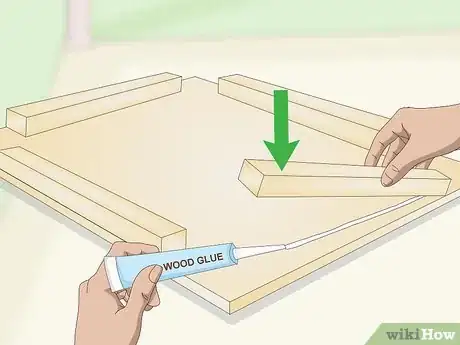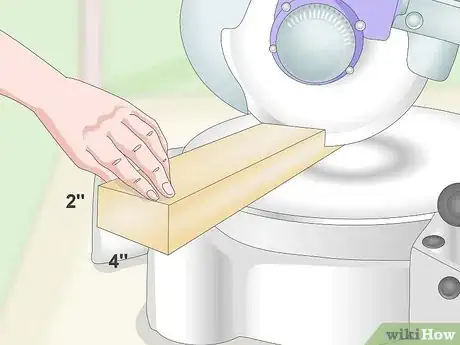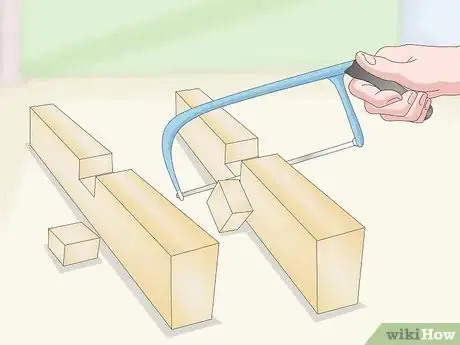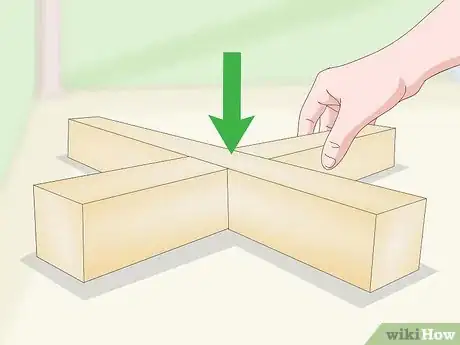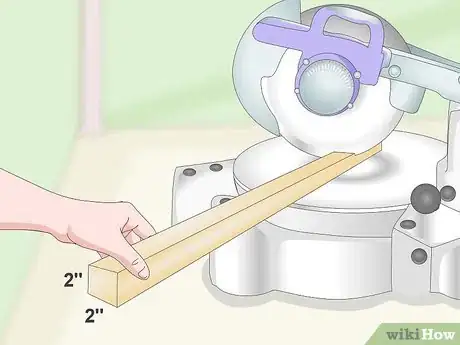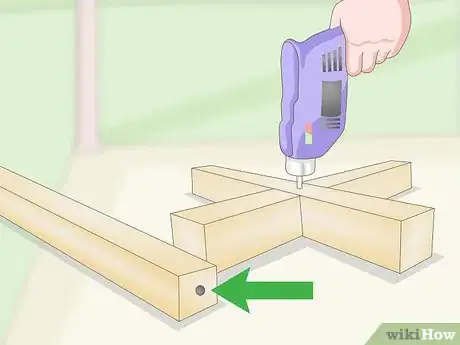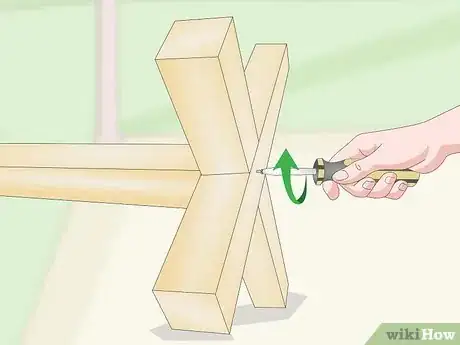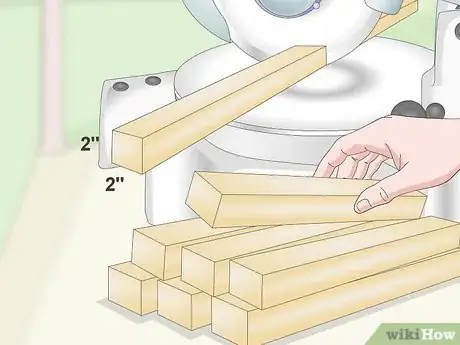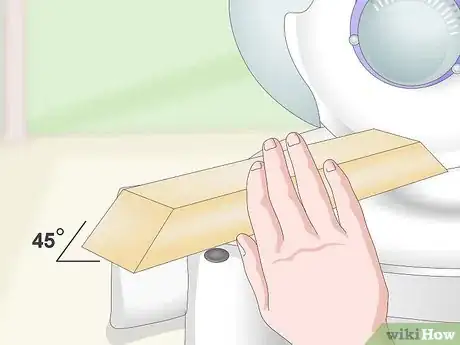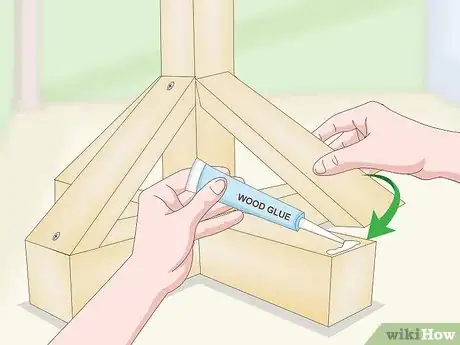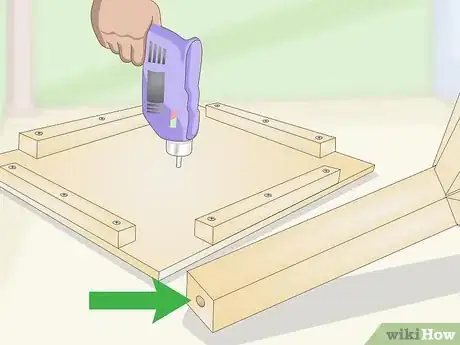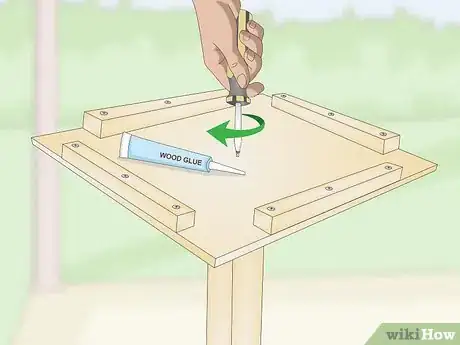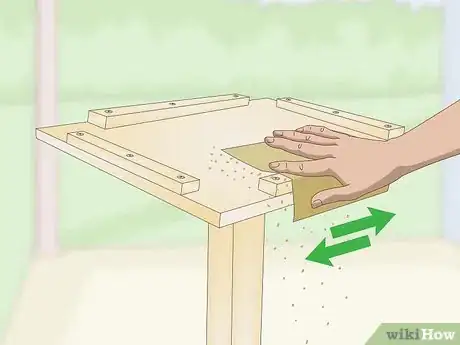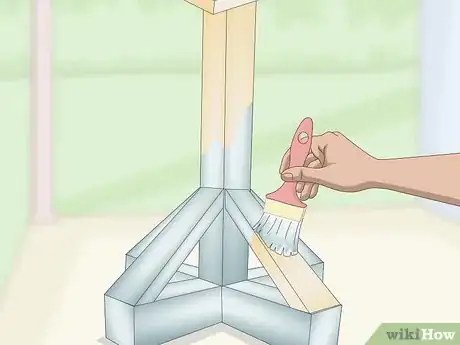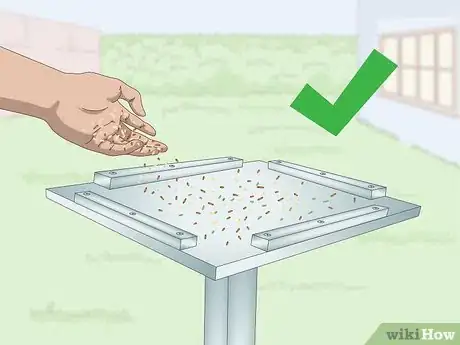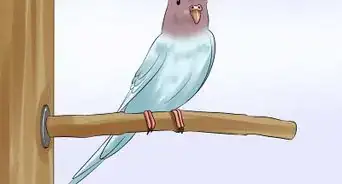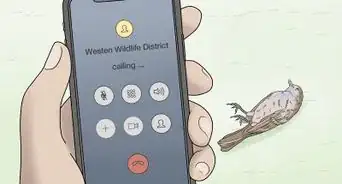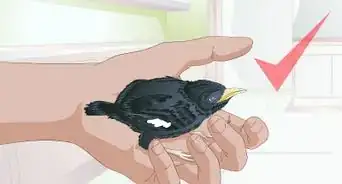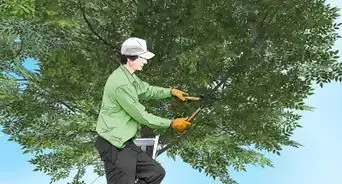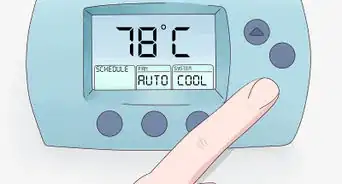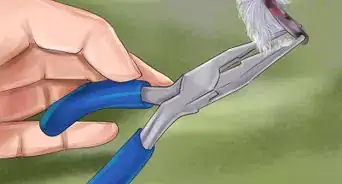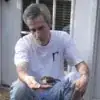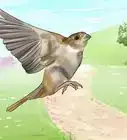This article was co-authored by Jeff Jones. Jeff Jones is a Bird Specialist based in Nashville, Tennessee. He is the writer of BirdOculars, a website dedicated to helping people become better birders. He has over 18 years of experience and specializes in feeding birds and wildlife. Jeff experiments to find ways to encourage birds he wants to study and his website help others to do the same.
There are 12 references cited in this article, which can be found at the bottom of the page.
wikiHow marks an article as reader-approved once it receives enough positive feedback. In this case, 82% of readers who voted found the article helpful, earning it our reader-approved status.
This article has been viewed 136,538 times.
A bird table is a wonderful way to attract birds to your garden and keep them fed at the same time. While bird tables or other bird feeders are available to buy from your local hardware store, they’re easy to make with some wood and a little time. By constructing the tabletop and the base separately before combining them, you can put a beautiful and functional bird table together in an afternoon.
Steps
Constructing the Tabletop
-
1Trim a large, 1⁄2 inch (1.3 cm) thick piece of wood to your desired size. Use a measuring tape to mark out the desired size of your bird table tabletop. With a handsaw or circular saw, trim off any excess wood to bring your tabletop to the right size.[1]
- If you’re unsure, start with a tabletop roughly 12 by 18 inches (30 by 46 cm) in size.
- The top of your table won’t need to support a large amount of weight, so any large sheet of wood should work.
- Make sure the wood you use for the tabletop and all other parts of the table is properly weather treated. If it’s not, you can waterproof the wood yourself.
-
2Cut 4 pieces of 1 by 1 in (2.5 by 2.5 cm) wood to make trim for the table. Trim around the edges of the table will help prevent the bird food from being blown away. Cut 4 pieces of 1 by 1 in (2.5 by 2.5 cm) wood so that they are roughly 2 inches (5.1 cm) shorter than the each of the edges of your tabletop.[2]
- Making the trim shorter than the tabletop will allow water to drain off it when it rains.
- If you’re making a table that is 12 by 18 inches (30 by 46 cm) in size, for example, you will need 2 pieces of trim 10 inches (25 cm) in length and 2 pieces that are 16 inches (41 cm) long.
Advertisement -
3Glue the wooden trim to the middle of each edge on the tabletop. Use a tape measure to find and mark the middle of each side on your tabletop and each piece of trim wood. Cover one side of each piece of trim with a small amount of wood glue and press it onto the tabletop. The edge should be flush with the edge of the tabletop, and the 2 marks made should line up.[3]
- Use clamps to hold the wood in place as the glue dries fully.
- Make sure that you put the smaller pieces of trim on the shorter sides of the table.
- You should have a flat tabletop with trim around the edges, leaving a small gap between each piece of trim in the 4 corners.
- The wood glue should be dry after around 30 minutes to 1 hour. Check the instructions on your specific brand of wood glue for further advice on drying times.
-
4Screw the trim into place. While the wood glue will hold the trim steady, it won’t be as long-lasting as screwing the trim in place. Use 1 1⁄2 in (3.8 cm) wood screws or deck screws to drill through the bottom of the tabletop and into the pieces of trim. Use 3 screws on each piece, with 1 in the middle and 1 roughly 1 inch (2.5 cm) from each end.[4]
- To make sure the screws go into the wood straight, drill some pilot holes first. Use a 3⁄32 inch (0.24 cm) drill bit to drill a small hole through the bottom of the tabletop and roughly 1⁄2 inch (1.3 cm) into the trim.
Building the Base
-
1Cut 2 pieces of 2 by 4 in (5.1 by 10.2 cm) wood to the length of the tabletop. In order to ensure the bird table can stand properly, you will need a wide base to support it. Measure 2 pieces of 2 by 4 in (5.1 by 10.2 cm) wood to the largest dimension of your tabletop and cut it to this size.[5]
- If you’re making a bird table that is 30 by 50 inches (76 by 127 cm) in size, your 2 base pieces should be 50 inches (130 cm) in length.
- This will make a very sturdy table, but you could also make the base smaller than this. Try finding a measurement between the 2 dimensions of your tabletop. Anything too much smaller than the shorter dimension may be too unsteady, but something halfway between should work well.
- If you don’t want to make a base for your bird table, you could also screw it into the top of a wooden fence post installed somewhere in your yard.
-
2Remove a 1 by 4 in (2.5 by 10.2 cm) notch from the center of each piece of wood. Use a tape measure to find the middle of each piece of wood and mark a point 2 inches (5.1 cm) away from the middle in each direction. Use a circular saw, table saw, or even a handsaw to cut a notch into the 2 pieces of wood, 1 inch (2.5 cm) deep in between the 2 marks you made.[6]
- This should leave you with a 4 in (10 cm) wide notch that goes halfway through each piece of wood.
-
3Connect the 2 pieces of wood to create a cross. Turn 1 piece of wood upside down and rotate it 90-degrees so that the 2 notches on the wood match up. Press the notches together and use a rubber or wooden mallet to knock them into each other. If the notches are cut correctly and this is done properly, you should have a flat cross of wood.
- This will create a flat bottom on which the bird table can sit.
- For extra stability, cover the inside of each notch with a little wood glue to hold the cross together.
-
4Trim a 2 by 2 in (5.1 by 5.1 cm) post to the desired height of your bird table. The post is what will connect the base of the bird table to the tabletop itself. Measure a 2 by 2 in (5.1 by 5.1 cm) post to be roughly 3 feet (91 cm) in length and use a saw to cut it to down to size. Make sure that the cut is as flat and straight as possible to avoid a crooked bird table.[7]
- If you have a different wooden post that you’d like to use, such as an old table leg or a different dimension of wood, this will work as well. Make sure it's not bigger than 4 by 4 inches (10 by 10 cm), or else it will overlap the wooden base.
-
5Drill a pilot hole in the center of the post and the wooden cross. Use a measuring tape to find and mark the middle of both the wooden post and the cross. Attach a 3⁄32 inch (0.24 cm) drillbit to an electric drill and drill through the center of the wooden cross. Repeat on the base of the wooden post, going roughly 1⁄2 inch (1.3 cm) into the post.
- A pilot hole will help make sure that screws go in properly and that everything is lined up perfectly.
- Rather than using a measuring tape, you can rule a straight line from each diagonal corner of the wooden post. The place where the 2 lines intersect is the center.
-
6Screw the cross and the post together. Turn the wooden post upside down so that the pilot hole is facing upward. Place the wooden cross over the post so that the pilot holes line up perfectly. Use an electric drill or screwdriver to screw in a 3 in (7.6 cm) deck or wood screw until it is flush with the bottom of the cross.[8]
- For extra stability, you could drill pilot holes and add additional screws in other corners of the post. This will prevent it from rotating, so make sure it is perfectly square with the base before doing so.
-
7Cut 8 12 in (30 cm) pieces of 2 by 2 in (5.1 by 5.1 cm) wood. These will form the braces that will keep the post connecting the top and bottom of the table steady. Use a tape measure to mark 8 lengths of 2 by 2 in (5.1 by 5.1 cm) wood at 12 inches (30 cm). Use a handsaw or something similar to cut them to size.[9]
- If you are using a smaller base or making a larger table, you may need braces of a different size. Position a ruler at a 45-degree angle between the post and brace. Adjust it until the length looks good relative to the size of your table and use that measurement instead.
-
8Cut a 45-degree angle into each end of your cut wooden braces. Working 1 piece at a time, clamp a wooden brace into a miter box or onto a circular saw that can cut on an angle. Set the saw or miter box to a 45-degree angle and begin cutting your braces. Repeat for each end of each brace until you have 8 even trapezoids.[10]
- If you don't have a miter box or circular saw, you could also mark a 45-degree line on the wood with a protractor and pencil. This won't be as accurate, but with a little extra sanding and some wood glue, it should still be functional.
-
9Glue and screw the angled wood to each side of the post and cross. Coat the angled sides of each piece of wood with a small amount of wood glue. Press each piece onto the faces of the cross and post to create a triangle with the corner between them. Screw 1 1 1⁄2 in (3.8 cm) wood screw through each end of the angled wood into the face of the post and into the cross.[11]
- It may help to drill pilot holes with a 3⁄32 inch (0.24 cm) drillbit first.
- The screws should go through the angled wood at an angle so that they go into the post or the cross completely straight.
Assembling the Table
-
1Drill a pilot hole through the center point of the tabletop and the wooden post. Use a measuring tape to find and mark the center point of both the wooden tabletop and the post on which you’ll be mounting it. Use a 3⁄32 inch (0.24 cm) drill bit to drill through the center of the tabletop and the center of the wooden post.[12]
- This will help ensure that the tabletop is perfectly balanced on the post and perfectly centered.
- You can also find the middle point of a post and the tabletop by drawing a straight line between each diagonal corner. The point where they intersect is the middle.
-
2Glue and screw the tabletop to the wooden post. Coat the top of the post with a small amount of wood glue. Place the tabletop onto the post so that the 2 pilot holes line up. Screw a 1 1⁄2 in (3.8 cm) wood screw through the pilot hole in the tabletop and into the wooden post.[13]
- For extra stability, drill extra screws through the tabletop and into the post.
-
3Sand down the entire table. Any sharp edges or splintering wood on the table may catch or hurt birds that try and eat from it. Use a medium grit sandpaper, around 120-grit, to sand down all exposed areas on your table to a smooth finish.[14]
- If you have an orbital sander available, it will make this process go much faster.
-
4Stain or paint the table if you want to change its color. If the standard color of the wood you used doesn’t look great in your yard, you could stain or paint it a different color. Choose a paint or wood stain that is graded for external use and apply it to the bird table according to the manufacturer’s instructions.[15]
- Make sure that whichever paint or stain you choose won’t be harmful to any birds. As they eat off the table, they may ingest small amounts of paint or stain, so make sure it is completely non-toxic.
-
5Place the table in your yard and scatter birdseed over it. Once the table is assembled and completely sanded, it’s ready to be displayed and used. Place the bird table in an exposed and easily accessible area of your yard or garden and scatter it with a few small handfuls of bird seed.[16]
- You can buy bird seed online or from your local pet store.
- For extra stability, hammer some metal or wooden pegs into the ground on either side of each plank in the base of your table. Tie a piece of rope over each plank between the pegs to hold the table in stronger winds.
Expert Q&A
-
QuestionWhat type of food should I leave on a bird table?
 Jeff JonesJeff Jones is a Bird Specialist based in Nashville, Tennessee. He is the writer of BirdOculars, a website dedicated to helping people become better birders. He has over 18 years of experience and specializes in feeding birds and wildlife. Jeff experiments to find ways to encourage birds he wants to study and his website help others to do the same.
Jeff JonesJeff Jones is a Bird Specialist based in Nashville, Tennessee. He is the writer of BirdOculars, a website dedicated to helping people become better birders. He has over 18 years of experience and specializes in feeding birds and wildlife. Jeff experiments to find ways to encourage birds he wants to study and his website help others to do the same.
Bird Specialist Try putting out sunflower seed and see which birds come over to eat it. Then, spend some time observing the birds that come to the table and tailor the food to attract the ones you want to stay there.
Try putting out sunflower seed and see which birds come over to eat it. Then, spend some time observing the birds that come to the table and tailor the food to attract the ones you want to stay there. -
QuestionHow can I make an existing table taller?
 Marion MoldovanCommunity AnswerTo make an existing table taller, you could use bed risers, bun feet, or PVC pipe to extend the legs.
Marion MoldovanCommunity AnswerTo make an existing table taller, you could use bed risers, bun feet, or PVC pipe to extend the legs. -
QuestionWhat are the recommended measurments?
 Marion MoldovanCommunity AnswerThe recommended measurements depend on the dimensions of the birds you want to attract. You want to make sure they have room to perch on the side of the table.
Marion MoldovanCommunity AnswerThe recommended measurements depend on the dimensions of the birds you want to attract. You want to make sure they have room to perch on the side of the table.
Warnings
- Once you start putting birdseed on your table, many birds will come to rely on this source of food. If you want to cease feeding birds, do not do so until the warmer months, when finding food is much easier for the birds and they can safely wean themselves off your supply.⧼thumbs_response⧽
- If you use any sealant, paint or varnish on the bird table, be certain it is bird safe. Many of the common stains, paints, polishes, and glues that humans can tolerate are poisonous to birds.⧼thumbs_response⧽
Things You’ll Need
- 1⁄2 inch (1.3 cm) thick sheet of wood
- Tape measure
- Handsaw or circular saw
- 1 by 1 in (2.5 by 2.5 cm) wood
- Clamps
- Wood glue
- Electric drill
- 1 1⁄2 in (3.8 cm) wood or deck screws
- 2 by 4 in (5.1 by 10.2 cm) wood
- Rubber or wooden mallet
- 2 by 2 in (5.1 by 5.1 cm) post
- 3 inches (7.6 cm) wood or deck screw
- Miter saw or circular saw
- 1 by 2 in (2.5 by 5.1 cm) wood
- Medium grit sandpaper, around 120-grit
- Wood stain or paint (optional)
- Bird seed
References
- ↑ https://www.rspb.org.uk/birds-and-wildlife/advice/how-you-can-help-birds/feeding-birds/all-about-bird-tables/making-a-bird-table/
- ↑ https://www.rspb.org.uk/birds-and-wildlife/advice/how-you-can-help-birds/feeding-birds/all-about-bird-tables/making-a-bird-table/
- ↑ http://www.askaboutireland.ie/enfo/sustainable-living/how-to/make-a-bird-table/how-can-i-make-one/
- ↑ http://www.askaboutireland.ie/enfo/sustainable-living/how-to/make-a-bird-table/how-can-i-make-one/
- ↑ https://www.rspb.org.uk/birds-and-wildlife/advice/how-you-can-help-birds/feeding-birds/all-about-bird-tables/making-a-bird-table/
- ↑ https://youtu.be/pYigNLrQh5M?t=267
- ↑ https://youtu.be/pYigNLrQh5M?t=177
- ↑ https://youtu.be/pYigNLrQh5M?t=294
- ↑ https://youtu.be/pYigNLrQh5M?t=203
- ↑ https://youtu.be/pYigNLrQh5M?t=203
- ↑ https://youtu.be/pYigNLrQh5M?t=328
- ↑ https://youtu.be/pYigNLrQh5M?t=376
- ↑ https://youtu.be/pYigNLrQh5M?t=390
- ↑ https://www.todayshomeowner.com/video/how-to-choose-the-right-sandpaper-grit-for-the-job/
- ↑ https://youtu.be/pYigNLrQh5M?t=610
- ↑ https://youtu.be/pYigNLrQh5M?t=724
About This Article
To build a bird table, start by trimming a large, flat piece of wood down to your desired size to create the tabletop. Next, cut 4 pieces of wooden trim and screw the pieces onto the underside of the tabletop. Then, secure 2 pieces of wood together in a cross shape to form the table's base and attach a sturdy post to the center. Finally, add a few pieces of angled wood as braces for the post before screwing the tabletop on top of the post. For tips on sanding and painting your assembled table, read on!


